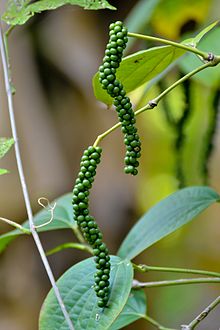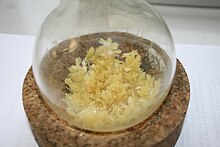Piperine
| Structural formula | |||||||||||||||||||
|---|---|---|---|---|---|---|---|---|---|---|---|---|---|---|---|---|---|---|---|

|
|||||||||||||||||||
| General | |||||||||||||||||||
| Surname | Piperine | ||||||||||||||||||
| other names |
|
||||||||||||||||||
| Molecular formula | C 17 H 19 NO 3 | ||||||||||||||||||
| Brief description |
beige solid |
||||||||||||||||||
| External identifiers / databases | |||||||||||||||||||
|
|||||||||||||||||||
| properties | |||||||||||||||||||
| Molar mass | 285.34 g mol −1 | ||||||||||||||||||
| Physical state |
firmly |
||||||||||||||||||
| Melting point |
127-130 ° C |
||||||||||||||||||
| solubility |
poor in water (40 mg l −1 , 18 ° C) |
||||||||||||||||||
| safety instructions | |||||||||||||||||||
|
|||||||||||||||||||
| Toxicological data | |||||||||||||||||||
| As far as possible and customary, SI units are used. Unless otherwise noted, the data given apply to standard conditions . | |||||||||||||||||||
Piperine ( 1-piperoylpiperidine ) is a piperidine alkaloid of the group of acid amide - alkaloids . It is the amide of piperic acid and piperidine and forms a colorless to yellowish solid with a monoclinic prismatic crystal structure. Piperine was first isolated by Hans Christian Ørsted in 1819 .
Occurrence and synthesis
Piperine is the main alkaloid of black pepper ( Piper nigrum ) and the carrier of the pungent pepper taste. It is found to 5% to 8% in black pepper, also in white pepper , in long pepper and 0.4% in cubeb pepper .
The starting point for biosynthesis in plants is L-lysine , which is decarboxylated after binding to pyridoxal phosphate. Oxidative deamination produces 5-aminopentanal, which is cyclized to ∆ 1 -piperideine. After its reduction, piperine is formed by reaction with piperic acid with the escape of water. Piperic acid is provided by the condensation of malonyl coenzyme A and an activated cinnamic acid derivative . Piperic acid can be replaced by other acids, so that about 50 piper alkaloids occur.
Piperine can be synthesized from piperidine and piperic produce, but can also with black pepper ethanol extracted and then crystallized be.
properties
With alcoholic potassium hydroxide solution , piperine can be split into piperidine and piperic acid with absorption of water.
Since formaldehyde can also be split off through acid catalysis (including in the stomach), large quantities of it can be harmful.
Similar to capsaicin , piperine also has a pungent taste . In the case of piperine, this is linked to the trans-trans position [( E, E )] of the two double bonds. Under the influence of light, isomers with ( Z, Z ) - ( chavicin , cis-cis ), ( Z, E ) - ( isopiperine , cis-trans ) and ( E, Z ) structure ( isochavicin , trans- cis isomer). This leads to the spice losing its sharpness.
pharmacology
In 1979 piperine was described as the first bioenhancer . There are indications that piperine increases the bioavailability of other substances, such as turmeric and ibuprofen (avoidance of the first-pass effect , increased absorption in the gastrointestinal area).
Like all sharp substances, piperine stimulates the metabolism and secretion (saliva, digestive juices) and has an antimicrobial effect . It is therefore occasionally taken to support a fasting cure. It is increasingly used as a dietary supplement in bodybuilding and weight training. The pharmaceutical industry is also researching piperine. Piperine is also touted as a weight loss wonder drug. A study on the effects of piperine on human cell cultures was carried out under the direction of Ui-Hyun Park at Sejong University in Seoul , which showed that the substance was able to slow down the formation of new fat cells. An effectiveness against obesity in humans cannot, however, be derived from this.
Individual evidence
- ↑ a b c d e f data sheet piperine (PDF) from Merck , accessed on April 21, 2011.
- ↑ a b Entry on piperine in the ChemIDplus database of the United States National Library of Medicine (NLM) .
- ^ A b Toxicology Letters . Volume 16, p. 351, 1983.
- ↑ Albert Gossauer: Structure and reactivity of biomolecules . 2006, ISBN 3-906390-29-2 , pp. 249 .
- ↑ a b c piperine. In: Lexicon of Nutrition. Retrieved April 9, 2019 .
- ^ Theo Dingermann, Karl Hiller, Georg Schneider, Ilse Zündorf: Schneider - drug drugs. Spektrum Akademischer Verlag, Heidelberg 2004, ISBN 3-8274-1481-4 , p. 438.
- ↑ Entry on piperine. In: Römpp Online . Georg Thieme Verlag, accessed on July 27, 2011.
- ↑ CK Atal: A breakthrough in drug bioavailability-a clue from age old wisdom of Ayurveda . In: IMDA Bulletin . tape 10 , 1979, p. 483-484 .
- ↑ Hot against fat . bdw, Wissenschaft.de. May 4, 2012. Retrieved October 28, 2016.



